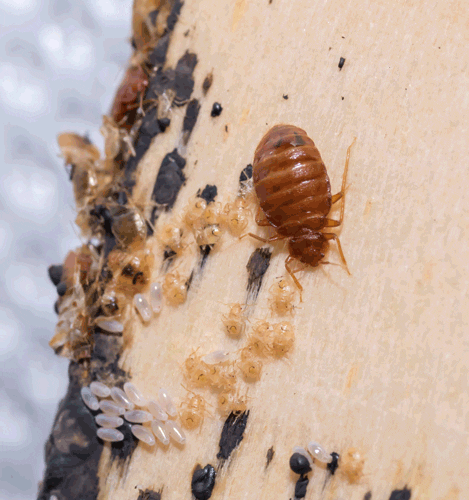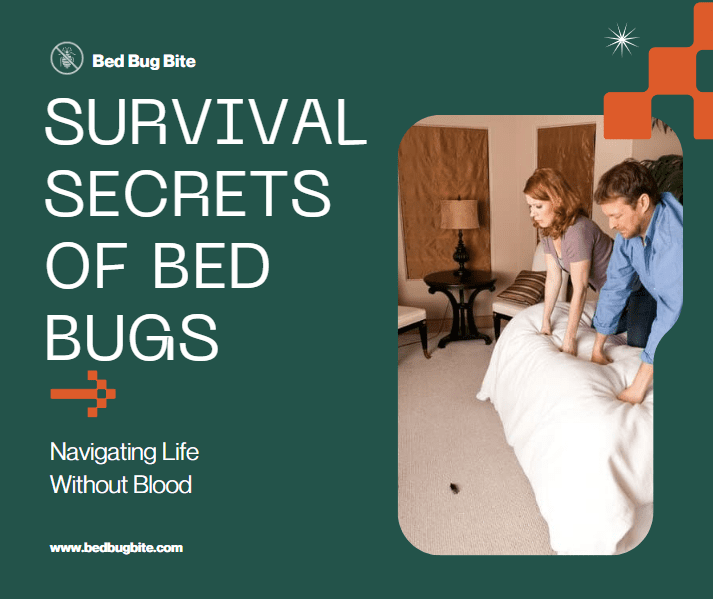Introduction: Deciphering the Resilience of Bed Bugs
Survival Secrets of Bed Bugs. Dive into the hidden world of bed bugs. The small but formidable foes that have become a widespread concern in both residential and commercial spaces. This detailed exploration sheds light on a fascinating aspect of bed bug biology. Their uncanny ability to live without their essential nourishment: blood. Gaining insights into how bed bugs withstand periods of famine is crucial for devising effective pest control strategies and achieving a living space free from these unwelcome guests. …Click Here to Keep Reading About Bed Bugs!
Bed bugs are known for their discreet presence, emerging from the shadows to feed on blood, which is critical for their development and reproduction. Yet, it is their extraordinary capability to survive without feeding that makes them particularly challenging to eradicate. Through understanding the lifecycle of bed bugs, including their progression from egg to nymph to adult, we uncover the resilience that enables them to remain hidden and survive in our homes against the odds.
A Closer Look at Bed Bug Biology and Survival Tactics
In this guide, we delve into the biological traits and behaviors that empower bed bugs to endure long stretches without a blood meal. We examine how environmental conditions, developmental stages, and other factors influence their survival capabilities. This knowledge is not merely academic. It has practical applications in the real world. Offering enhanced strategies for homeowners and pest professionals alike in the fight against bed bug infestations.
Armed with this information, we aim to provide you with the expertise needed to confront bed bug issues confidently, ensuring a serene and pest-free environment.
Continuing our journey, we will dissect the mechanisms that enable bed bugs to survive without blood, investigate the variables affecting their ability to withstand hunger. Highlighting effective measures to prevent and manage infestations. Our exploration is supported by authoritative sources such as the Environmental Protection Agency (EPA). Which offers a comprehensive overview of bed bug life stages, feeding patterns, and management techniques. (EPA Bed Bugs Information)
Stay with us as we navigate the intricacies of bed bug survival and unveil strategies to ensure your home remains a sanctuary, free from the nuisance of bed bugs.
Understanding Bed Bugs: Biology and Behavior
Venturing deeper into the world of bed bugs, it’s essential to grasp the fundamentals of their biology and behavior to combat them effectively. These tiny pests, known for their flat, oval bodies that are reddish-brown in color, are not just a nuisance but are marvels of survival. Their life cycle, which encompasses eggs, nymphs, and adults, reveals a journey of resilience and adaptation in the face of adversity.
Physical Characteristics: The Bed Bug’s Disguise

The physical makeup of bed bugs plays a crucial role in their survival. Their flat bodies allow them to squeeze into tiny cracks and crevices, going unnoticed for months. This ability to hide in plain sight is what makes bed bugs such formidable opponents in the battle against infestations.
The Lifecycle of a Bed Bug: Stages of Survival
Understanding the lifecycle of bed bugs is key to controlling them. It begins with the egg. Which is about the size of a speck of dust, making it incredibly difficult to detect. As bed bugs progress through five nymphal stages, they require at least one blood meal to molt and advance to the next stage. Finally, as adults, they continue this cycle of feeding and reproduction, completing their lifecycle within months, depending on conditions.
Feeding Habits: The Quest for Blood
Bed bugs are primarily nocturnal, emerging from their hiding places at night to feed on unsuspecting hosts. Their quest for blood is driven by a need for nutrients to support their growth, reproduction, and longevity. Interestingly, while bed bugs prefer human blood, they can also feed on other warm-blooded animals if necessary.
In this section, we’ve peeled back the layers to reveal the intricate biology and behavior of bed bugs. By understanding these aspects, we are better equipped to identify signs of bed bugs early and implement effective strategies to prevent their spread. As we move forward, we’ll explore the survival mechanisms of bed bugs in the absence of their primary food source. Shedding light on their remarkable ability to endure without blood for extended periods.
The Survival Mechanism of Bed Bugs without Blood
The ability of bed bugs to survive without their essential nourishment—blood—is a fascinating aspect of their resilience. Presenting a significant challenge in controlling their populations. This survival mechanism is not just a mere inconvenience; it is a critical factor that makes bed bugs formidable pests. Let’s delve into how these tiny invaders manage to survive periods of famine and what this means for their control.
Adaptations for Survival: Metabolism and Dormancy
Bed bugs possess remarkable biological adaptations that allow them to conserve energy and resources during times when blood meals are scarce. Their metabolism slows down, reducing their need for food and enabling them to survive for months without feeding. This state of low metabolic activity is akin to dormancy. Allowing bed bugs to live through unfavorable conditions until they can access a blood meal again.
Dormancy: A Bed Bug’s Survival Strategy
When bed bugs enter a state of dormancy, they become less active and can survive in this state for extended periods. This survival strategy is particularly troublesome for homeowners and pest control professionals because bed bugs can re-emerge and resume their activity once favorable conditions return, such as the presence of a host.
Understanding the survival mechanisms of bed bugs in the absence of blood is crucial for effective pest management. It highlights the importance of comprehensive and sustained control measures that do not solely rely on the immediate presence of bed bugs but also consider the possibility of dormant populations. As we further explore the factors influencing bed bug starvation periods, it becomes evident that effective management requires a strategic approach that encompasses monitoring and prevention to ensure long-term control.
Factors Influencing Bed Bug Starvation Periods
The duration that bed bugs can survive without feeding is influenced by a variety of factors. Each playing a crucial role in their ability to withstand periods of starvation. Understanding these factors is vital for developing strategies to control and prevent bed bug infestations. Let’s explore the key elements that determine how long bed bugs can live without their blood meal.
Temperature: The Environmental Impact
Temperature significantly affects bed bug metabolism and, consequently, their survival rate without food. In cooler conditions, bed bugs can conserve energy and survive longer periods without feeding. Conversely, warmer environments may accelerate their metabolism, reducing the time they can survive without a blood meal. This relationship between temperature and bed bug survival highlights the importance of considering environmental conditions when assessing infestation risks and implementing control measures.
Life Stage: Nymphs vs. Adults
The survival capabilities of bed bugs vary between their life stages. Nymphs, being younger and having less energy reserves, typically require more frequent feedings to sustain their growth and development. Adult bed bugs, on the other hand, have greater resilience and can survive longer without feeding. This distinction is crucial for understanding infestation dynamics and targeting control efforts effectively.
Health and Reproduction: The Effects of Starvation
A lack of blood meals impacts not only the survival of bed bugs but also their reproduction and overall health. Starvation can lead to reduced fertility in adults, slowing the growth of bed bug populations. However, even a single feeding can enable bed bugs to resume their reproductive cycle. Emphasizing the need for consistent and thorough pest control practices.
Understanding the factors that influence bed bug starvation periods provides valuable insights into their behavior and survival strategies. By taking into account the environmental conditions, life stages of bed bugs, and the impact of starvation on their health and reproduction. Pest management professionals and homeowners can devise more effective approaches to control and prevent bed bug infestations, ensuring a more comprehensive and successful eradication effort.
Real-World Implications: Home Infestation Scenarios
The resilience of bed bugs, particularly their ability to survive long periods without feeding, has significant implications for home infestations. This trait complicates the process of eliminating bed bugs from residential settings, as they can remain hidden and dormant. Only to re-emerge once conditions become favorable again. Understanding common infestation scenarios and the challenges they present is crucial for homeowners looking to maintain a bed bug-free environment.
Common Scenarios and Challenges
One frequent scenario involves bed bugs surviving treatment efforts due to their ability to remain dormant and undetected in hidden locations within the home. This ability for bed bugs to “wait out” treatment measures can lead to a resurgence of infestation weeks or even months after initial extermination efforts. Highlighting the need for comprehensive and sustained control strategies.
Preventing Re-infestation

Preventing re-infestation requires more than just a one-time treatment; it necessitates a multi-faceted approach. This includes regular inspections, prompt treatment of suspected infestations, and ongoing preventative measures to deter bed bugs. Educating residents on signs of bed bugs and encouraging proactive behaviors. Such as vacuuming and decluttering, can also play a key role in preventing bed bug resurgence.
Effective Strategies for Managing Infestations
The challenge of managing bed bug infestations underscores the importance of combining immediate treatment with long-term prevention strategies. Utilizing a combination of chemical and non-chemical treatments, maintaining vigilance for signs of bed bugs, and implementing environmental controls such as reducing clutter and sealing entry points are all essential components of a successful bed bug management plan.
The real-world implications of bed bug survival strategies, particularly their ability to live without blood for extended periods, necessitate a comprehensive and informed approach to pest management. By understanding the challenges presented by common infestation scenarios and implementing effective prevention and treatment strategies, homeowners can enhance their efforts to maintain a bed bug-free home.
Proactive Measures: Preventing Bed Bug Survival
To safeguard our homes and spaces from the persistence of bed bugs, proactive measures are essential. These strategies not only aim to reduce the chances of bed bug survival but also prevent their spread and re-infestation. Let’s delve into the key actions that can be taken to keep these unwelcome guests at bay.
Regular Inspection and Cleaning: The First Line of Defense
One of the most effective strategies for preventing bed bug survival is regular inspection and cleaning. This includes checking beds, furniture, and cracks in walls for signs of bed bugs, such as live insects, eggs, fecal spots, and shed skins. Vacuuming regularly and decluttering spaces can reduce hiding spots for bed bugs, making it harder for them to survive unnoticed.
Professional Extermination Options: Ensuring Thorough Eradication
For infestations that cannot be controlled through cleaning and home remedies, professional extermination becomes necessary. Pest control professionals have access to a range of effective treatments, including chemical pesticides, heat treatment, and freezing methods. These options can target bed bugs at all life stages, significantly reducing their chances of survival and re-infestation.
Integrated Pest Management (IPM): A Comprehensive Approach
Integrated Pest Management (IPM) is a strategy that combines multiple approaches for managing pests in the most effective and environmentally sensitive way. For bed bugs, this includes prevention, monitoring, and using control methods that pose the least risk to people, property, and the environment. IPM emphasizes the importance of ongoing education, proper sanitation, and the judicious use of pesticides as part of a holistic approach to pest management.
By adopting proactive measures, we can significantly reduce the survival and spread of bed bugs. Regular inspection and cleaning. Combined with professional extermination options and an integrated pest management approach, offer a comprehensive defense against these resilient pests. Taking these steps helps ensure our living environments remain comfortable and bed bug-free.
Innovative Solutions: Cutting-Edge Bed Bug Control
As we continue to seek more effective ways to combat bed bug infestations. Innovative solutions have emerged, marking a new era in pest control. These cutting-edge techniques not only offer promising results but also pave the way for safer, more environmentally friendly methods of eradication. Let’s explore some of the latest advancements in bed bug control and how they contribute to our ongoing battle against these persistent pests.
Heat Treatment: Turning Up the Heat on Bed Bugs
Heat treatment has become a game-changer in bed bug eradication. By raising the temperature in an infested area to levels that are lethal to bed bugs. This method can eliminate pests in all life stages, from eggs to adults. Heat treatment is particularly effective because it penetrates into cracks and crevices. Reaching bed bugs in hidden locations without the use of chemicals.
Freezing Techniques: A Chill Solution
Another innovative approach to bed bug control is the use of freezing techniques. By applying extreme cold to infested areas, bed bugs can be killed quickly and effectively. This method is especially appealing because it is non-toxic and leaves no residue. Making it safe for use in homes and around sensitive individuals.
Biological Control: Nature’s Pest Fighters
The exploration of biological control methods, including the use of natural predators or pathogens to combat bed bug populations, is an area of growing interest. While still in the early stages of research, the potential to harness nature’s own mechanisms for pest control offers an exciting prospect for sustainable, chemical-free solutions.
The Role of Monitoring and Detection Tools
Advancements in monitoring and detection technologies have also improved our ability to combat bed bugs. Devices that mimic the CO2 output and warmth of a human body can attract and trap bed bugs. Helping to identify infestations early and monitor the effectiveness of treatment strategies.
The development of innovative solutions in bed bug control represents a significant step forward in our ability to manage these pests. From heat treatment and freezing techniques to the exploration of biological controls and advanced monitoring tools. These cutting-edge methods are enhancing our arsenal against bed bugs, offering hope for more effective, sustainable, and safe eradication strategies.
Conclusion: Mastering Bed Bug Management
In our comprehensive journey through the hidden world of bed bugs, we’ve explored the intricate details of their survival, the factors that influence their longevity without blood, and the innovative strategies to control and prevent infestations. The resilience of bed bugs, coupled with their ability to survive under adverse conditions, underscores the need for a proactive and informed approach to pest management. By leveraging the insights and methods discussed, homeowners and pest control professionals can enhance their tactics, ensuring more effective bed bug eradication and prevention.
Empowering Homeowners and Professionals
Understanding the biology and behavior of bed bugs, along with the factors affecting their survival, equips us with the knowledge to tackle infestations more effectively. Regular inspections, cleanliness, and timely professional interventions are critical steps in maintaining bed bug-free environments.
Advancements in Bed Bug Control
The advent of innovative solutions, such as heat treatments, freezing techniques, and biological control methods, marks a new era in the fight against bed bugs. These methods, along with advanced monitoring and detection tools, offer promising avenues for safer and more efficient pest management strategies.
Staying Informed: The Key to Success
Continual education and awareness are paramount in the battle against bed bugs. Resources like the Environmental Protection Agency (EPA) and the Centers for Disease Control and Prevention (CDC) offer valuable information on bed bug management, health concerns, and prevention tips. Engaging with these resources can provide additional support and guidance for individuals and professionals alike.
Final Thoughts
The fight against bed bugs is ongoing, but with the right knowledge, tools, and strategies, it is a battle that can be won. By staying informed, adopting integrated pest management practices, and embracing innovative control methods, we can protect our homes and communities from the challenges posed by bed bugs. Together, we can achieve a future where bed bug infestations are effectively managed and ultimately, a rarity.
For further reading and resources, visit:
- Environmental Protection Agency (EPA) Bed Bugs
- Centers for Disease Control and Prevention (CDC) Bed Bugs FAQs
Through diligence, education, and the implementation of advanced control methods, mastering bed bug management is within reach, ensuring the well-being and comfort of our living environments.




